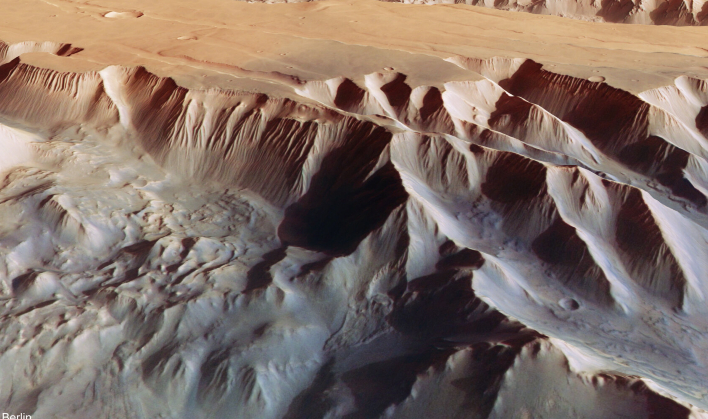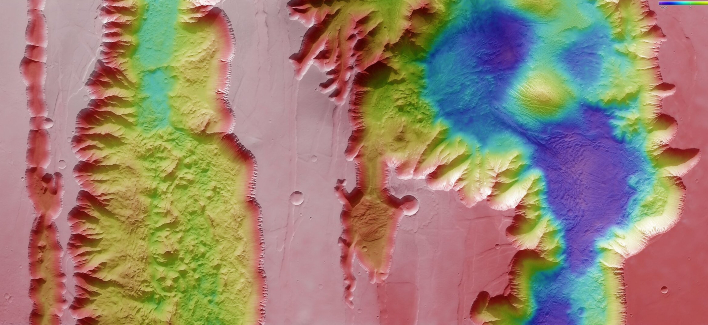Amazing Photos Show A Cosmic Grand Canyon On Mars That Dwarfs Ours Here On Earth
Photos from the European Space Agency's (ESA) Mars Express spacecraft show two ruptures in the surface of Mars that dwarf that of the Grand Canyon here on Earth. Valles Marineris is almost ten times longer, twenty times wider, and five times deeper than the Grand Canyon.
The images from the James Webb Space Telescope (JWST) have enamored us with objects in deep space. Being able to see things unlike anything we can peer at with our naked eye here on Earth has always given us a sense of awe and amazement. But sometimes images are received from the various spacecraft throughout space that remind us of things we are familiar with. Such is the case with recent photos sent back from Mars.
In the recent image from the Mars Express, the Valles Marineris is captured cutting through the Martian surface like the Grand Canyon does here on Earth. If it were located on our home planet, it would span the distance from the northern tip of Norway to the southern tip of Sicily. It is considered to be the largest canyon in the Solar System.
While having similarities to our own Grand Canyon, there is a big difference between the two. The Grand Canyon was created as the Colorado River cut through rock over a long period of time. Valles Marineris, however, is thought to have formed through the drifting apart of tectonic plates, according to ESA.
The images shared by ESA showcase two trenches (or chasma) that form part of the western Valles Marineris. On the left side of the image seen at the top of this story is the 840 km-long lus Chasma. On the right side of the image is the 805 km-long Tithonium Chasma.
The elevation map (seen above) shows how massive the depth of these chasms truly are. At its deepest it dips into the surface of Mars 7km. In comparison, the Alp's tallest mountain at 4809 m, Mount Blanc, would be dwarfed if it were put inside Tithonium Chasma.
Mounds can be seen in close-up images, that are more like mountains that rise more than 3000 meters in height. It is believed strong winds have eroded their surfaces, indicating that they are made up of weaker material than the surrounding rock.
If you would like to view more of the recent images from Mars Express, you can visit the ESA webpage.
The solar system we reside in is immense and filled with many extraordinary sights. Many times we are astounded at how different things are on other planets within our Solar System, while at the same time sharing similarities. As new images are shared by the various spacecraft exploring the vastness of space, the complexities and affinities will continue to amaze us.
The images from the James Webb Space Telescope (JWST) have enamored us with objects in deep space. Being able to see things unlike anything we can peer at with our naked eye here on Earth has always given us a sense of awe and amazement. But sometimes images are received from the various spacecraft throughout space that remind us of things we are familiar with. Such is the case with recent photos sent back from Mars.
In the recent image from the Mars Express, the Valles Marineris is captured cutting through the Martian surface like the Grand Canyon does here on Earth. If it were located on our home planet, it would span the distance from the northern tip of Norway to the southern tip of Sicily. It is considered to be the largest canyon in the Solar System.
While having similarities to our own Grand Canyon, there is a big difference between the two. The Grand Canyon was created as the Colorado River cut through rock over a long period of time. Valles Marineris, however, is thought to have formed through the drifting apart of tectonic plates, according to ESA.
The images shared by ESA showcase two trenches (or chasma) that form part of the western Valles Marineris. On the left side of the image seen at the top of this story is the 840 km-long lus Chasma. On the right side of the image is the 805 km-long Tithonium Chasma.
The elevation map (seen above) shows how massive the depth of these chasms truly are. At its deepest it dips into the surface of Mars 7km. In comparison, the Alp's tallest mountain at 4809 m, Mount Blanc, would be dwarfed if it were put inside Tithonium Chasma.
Mounds can be seen in close-up images, that are more like mountains that rise more than 3000 meters in height. It is believed strong winds have eroded their surfaces, indicating that they are made up of weaker material than the surrounding rock.
If you would like to view more of the recent images from Mars Express, you can visit the ESA webpage.
The solar system we reside in is immense and filled with many extraordinary sights. Many times we are astounded at how different things are on other planets within our Solar System, while at the same time sharing similarities. As new images are shared by the various spacecraft exploring the vastness of space, the complexities and affinities will continue to amaze us.




